The I Band
From Wakipedia, the free encyclopedia
This article is about the band - the I Band.
Shrouded in mystery, lost in history. The legend of a trio of gifted songwriters, but players of questionable talent, has been around the music world since the 60's.
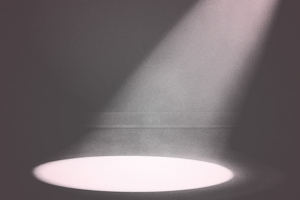
Dubbed "The I Band" by Lionel Twanes, a modern day researcher in 2005, in reality the legend gives us no clue to what they actually did call themselves during their brief tenure in the music scene from 1959 to 1966.
What the legend does say, however, is that they ghostwrote a large portion of the hit songs released from 1962 to 1966.
Could the legend be true?
There was an abrupt shift of musical style in popular (or young people's) music in the early 1960's. The use of the reliable "C, Am, F, G" progression and simple themes began to fade as new, more complex music came on the scene. Songs by The Beatles, Dave Clark Five, Bob Dylan, and others began to show up on the charts. Soon, even established acts, began to release songs in this new musical style.
Were these actually written by this legendary trio? Did they actually change the face of popular music?
Or is it just ... a myth.
The Early Years
Early on the morning of December 8th, 1941, three babies were found on the doorstep of Our Lady of Perpetual Motion Orphanage in Staten Island, NY. Each one had a note pinned to their blankets with their name, heritage and religion written on it, as was the custom of the time.
They were probably left by the wives of overzealous young men who ran off to war (WWII) in the wake of Pearl Harbor. The wives most likely wanted to present their husbands with new babies after they returned from the war and were afraid that these babies would not be suitable for the conquering heroes' return. Not knowing how long the war would last, the wives were afraid that the babies would have acquired that "old child" smell by the time their husbands returned.
Anyway, the notes read: "Alevio (call him Lev) Friedland, German, Jewish", "Harlan Willoughby, English, Jehovah's Witness", and "Nestor Gleason, Puerto Rican/Irish, Roman Catholic".
Their early years are shrouded in mystery - and probably too boring to recount here. Nevertheless, by the time they were teens, they were back at the orphanage, eating gruel and sleeping on the floor covered by threadbare blankets - or so we can assume based on what we know of orphanages in the late 1950's. They were most likely beaten by the Nuns in order to reinforce the religious instruction. Hi-ho. Hi-ho.
The Teen Years
Information regarding their teen years has been gleaned from old police reports and the diary of one of the older nuns at the orphanage, Sister Mary Incontina.
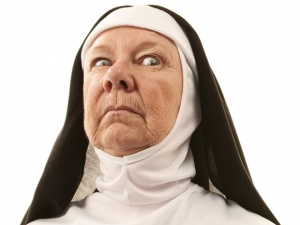
The research was difficult because the police records were salvaged from a fire in 1972 and stored in a damp basement, and there were unidentified brown stains on the pages of the diary.
The police reports that were legible detail the usual teenage pranks of the day - public urination, gambling, lewd behavior in a school district, killing small animals, kidnapping and arson.
The diary, however paints a different picture.
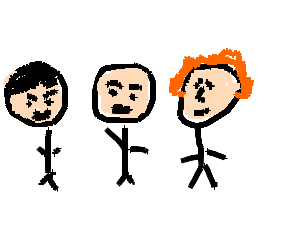
At Calumet College - The Musical Awakening
On June 29, 1958, an incident occurred in Birmingham, Alabama.
On that evening’s news, there was a report that a bomb was discovered in the Bethel Baptist Church during an evening service. Fortunately, it was removed to a nearby open field and safely exploded killing only a few cows, destroying one cornfield and vaporizing old Beauregard McDonald, an itinerant laborer who was hunting snipe in the moonlight.
The pastor, Rev. Fred Shuttlesworth, was a Civil Rights activist and this bombing attempt was obviously the work of the local KKK or, possibly, an experiment gone wrong by the local high school chemistry club, who met in the church basement on alternate Tuesdays.
This event deeply affected Lev, Harlan and Nestor, who were incoming freshmen at Calumet College in St. Joseph, Indiana - a Roman Catholic school of little note.
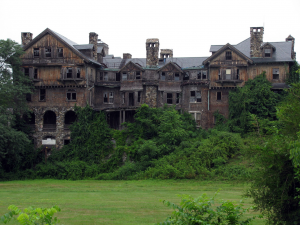
On the advice of Sister Mary Incontina, they had arrived on campus two months early to assure that they could find their way to their dorm, and because of the warrant out for them in Staten Island.
They understood the need for equality because of their own situation – a Jew, a Jehovah’s Witness and a Puerto Rican/Irish Catholic. From personal experience, they knew the value of mixing cultures – deli sandwiches, fear of transfusions, alcohol, eight days of presents, long walks, alcohol, borsht, meeting new people, alcohol … and their love of Pasteles.
They resolved to leave behind the safe, childhood pursuits of education, God and alcohol, and take up the battle for civil rights.
So … they decided to create a folk trio to sing protest songs.
The Band - Starting Out
They figured that the first thing they had to do (even before learning to play instruments or seeing if anyone could sing) was to pick a name.
At that time, group names were very important. There were acts named The Elegants, The Crickets, The Monotones and The Drifters, to name a few. Even in the folk music world, with The Weavers and The Kingston Trio, names were important.
They tried names like The Calumet Trio, The Knitters and Three Angry Guys before settling on The Heebie Geebies (sometimes spelled Heebie Jeebies). Note the similarity to The Bee Gees, who were formed around this time.
Coincidence? Perhaps not.
Anyway ... For six months they tried to get booked at local venues with no success. They were clueless as to the reason until one night as they were returning from a long walk with several bottles of Boone's Farm Apple Wine, they were grabbed, their heads covered with black hoods and they were thrown into a van. When they arrived at their destination, and the hoods were removed, they found themselves in a clearing, deep in the woods. Then suddenly, out of the darkness, came a dozen figures in pointed, white hoods and robes with a strange symbol ... a white German Cross within a red circle ... over their left breast.
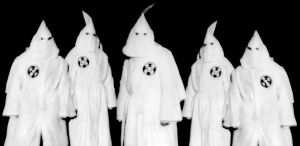
The leader spoke to them. "Listen here, boys. We don't like no Jew stuff around here. Saint Joseph, Indiana is a white, Christian community. You boys better stop this foolishness ... or else."
As quickly as they arrived, their heads were again covered with black hoods, they were shoved into a van, and before they knew it they were dumped out of the van at the exact spot where they were abducted.
Nestor, always the optimist, looked around and exclaimed, "Oh My God! The wine is still here! Are we lucky or what?" He quickly got the bag and hugged it to his chest (getting a little wet because two of the bottles had broken).
Harlan came to life, "Guys! Do you know what this means!! We have FANS!!!!" He began to dance around.
Lev looked up at them and said, "Hey, you goyish schmendricks. Can we get serious for a moment. Something just happened to us. Something PROFOUND. You know what's going on here?"
Nestor stood quietly as the wine started to wet his pants and Harlan stopped dancing.
Lev looked them both in the eyes, "It's clear to me. It should be clear to you. Our name is TERRIBLE. We have to change it if we are ever to get gigs and spread our message of Brotherhood, Equality and Freedom! Those folks did us a real favor."
Based on their experience, they went into seclusion in their dorm room. Weeks later, they emerged. They finally came up with a new name. And that name was ... Well, we don't really know what that name was, and so we use the name given to them by Twanes, et al - The I Band.
On to Minnesota
In August of 1959, right before the start of their sophomore year, the boys made a momentous decision that set them on the path that led to their becoming the legend that they became.
They had only gotten three gigs since January - performing as a clown trio at a child's birthday party, hiding the eggs for the Easter celebration at the Saint Joseph's Home for the Aged & Infirm, and setting up the chairs for a Pete Seeger concert at the college. It wasn't their dream, but it was show business.
After three weeks of discussion, they decided to go to the University of Minnesota Twin Cities in Minneapolis, Minnesota.
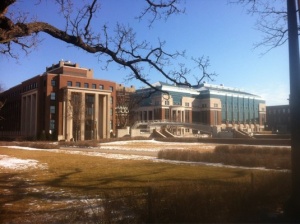
They had heard of the Dinkytown district, which was a hotbed for their kind of music.
They started their 426 mile journey on August 25, 1959 (a Tuesday). Legend says that they were forced to do unspeakable things along the way, but the less said the better.
Finally, on September 21, 1959, they arrived at the campus of the University of Minnesota Twin Cities. They decided to use The Knoll on the northwest part of the campus as their base of operations since most of the courses taught nearby were in the area of the humanities, and they were ... human, and the Dinkytown district was just to the north.
Once they buried their few belongings for safe keeping and woke up Nestor, they headed off for Dinkytown to search for potential venues.
Arriving there with few mishaps, they entered the first one they saw, The 10 O'Clock Scholar.
The booking agent at the “Scholar”, as it was affectionately called, was also the owner – a one eyed Norwegian expatriate known only as “Big Swede”, for reasons not immediately understood. He asked them a single question that changed their musical destiny … “So, what instruments dooya play?”
Realizing that this was a serious flaw in their plan, they excused themselves and went to The Knoll at U of M to discuss this new problem.
It soon became apparent that due to their lack of both funds and musical training this was a serious hiccup in their plans. It was at this point that Nestor sobered up enough to remark, “I gotta puke!” and then immediately passed out.
And with that, an idea burst forth in Lev’s mind. “Eureka!” he cried jumping to his feet.
With Nestor passing out and Harlan looking confused, Lev took their last ten dollars, swore to return and left. About 2 hours later, Lev returned with an old, beat up guitar with only 4 strings, a big cooking pot and a pair of spoons that he purchased at a local pawn shop.
He then revealed his plan … develop an act using these items as instruments until they could afford to buy real instruments and learn to play them. Lev figured they could get away with it as long as they threw words like “Equality”, “Freedom” and “Brotherhood” into their songs.
They all agreed (Nestor having woken up again) to give it the old college try. So they spent the rest of the afternoon writing and arranging six songs for spoons, four string guitar and big pot.
That evening, they returned to the “Scholar” and met with Big Swede again. Harlan did the talking … having discovered that his religious upbringing uniquely qualified him for this task.
Fifteen minutes later, they were booked for the next evening on the bill with Spider John Koerner, Dave Ray and a young U of M freshman, Bob Zimmerman.
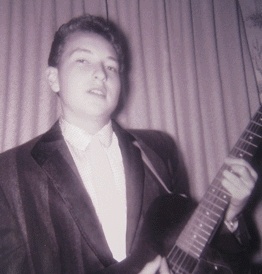
Giddy with their success, they retired to The Knoll to sleep under the stars and dream of their debut.
The Dinkytown Years
When they awoke the next morning, the good feeling had worn off and was replaced by the reality of hunger. That was until they realized they had spoons and a cooking pot.
Between foraging behind local eateries and capturing small animals, they were able to cook and fill their stomachs. This led to what some music historians think was their first great song, “Freedom is a Pot and Two Spoons”, which they debuted that evening.
Their performance that evening was terrible, but since most of the audience was "stoned" they didn't complain. Amazingly, Big Swede signed them to play 4 nights a week at the “Scholar” for two reasons: (1) Harlan negotiated the use of an unused back room for them to sleep in as payment for their performance, and (2) during their performance, Swede was in a back room "getting his eye patch adjusted" and missed their set.
During the next six months they played at the ”Scholar” in Minneapolis as well as the Purple Onion Pizza Parlor and The Bastille in St. Paul.
They became friendly with young Bob Zimmerman, who often played on the same bill with them, but just as often would sit in the audience with his High School girlfriend, Echo Helstrom, transfixed.

They would gather after each engagement and talk long into the night.
Bob’s musical career was stalled and soon, Echo stopped coming around … coming around ... coming around.
One evening at one of their late night “bull sessions”, Bob was complaining about his lack of success and asked the trio for their thoughts on what he could do differently.
The boys thought and finally came up with three things for Bob to do:
- Change his name. A Jewish sounding last name will keep him from getting booked in many places. Pick another name. An Irish name. Everybody likes an Irishman.
- Pick three words and try to use them in his songs. They suggested “Change”, “War” and “Freedom”. Or “Equality”. They were willing to share the latter two words.
- By the end of the year, move to New York City. There were more opportunities, and they were more tolerant toward Jews if anyone discovered his real last name.
Thus, Bob Dylan was born.
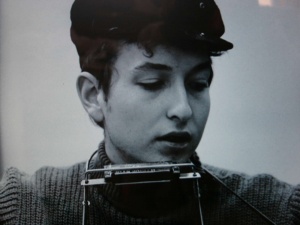
By early 1960, they became a popular musical curiosity throughout the Dinkytown / Minneapolis/St. Paul music scene.
In the Spring of 1960, with careful management of their funds, they were able to buy two more strings for the guitar, a washtub bass and a ukulele.
By the Fall of 1960, they could play those instruments somewhat, so they officially retired the spoons and pot and began to use the new instruments in their act. After some discussion, they decided not to discard their old “instruments” because as Lev famously said, “We gotta eat.”
Still, they felt something was missing. That thing that would validate them as a protest/folk group.
Because of that and the fact that Harlan was in a polygamous relationship with Esme, a "little person", and a librarian, Sweet Betsy from Pike (There was talk that her lover, Ike, was on the warpath with his old yeller dog, Bobo.), they decided to go "on tour" to spread their message.
Thus, the Freedom, Equality and Brotherhood Tour was born.
Freedom, Equality and Brotherhood Tour
The plan for the "F, E and B Tour" was to travel Northwest through North Dakota, Montana, Idaho and finally Washington State before turning South and heading toward Southern California. They would survive by getting bookings in venues along the way.
Unfortunately, they didn't take into account the sparsity of the population or lack of cities along the route.
When their meager funds ran out somewhere in Eastern Montana, they had to forego the luxury of bus transportation and rely on stealing rides in empty boxcars or by hitch hiking. Cold and hungry, they survived by rummaging through the garbage at roadside fast food restaurants and stealing napkins to stuff in their clothes for warmth.
Since they couldn't get bookings, they battled their boredom by writing songs on those napkins as they "rode the rails".
They began to have feelings of bitterness and hopelessness at this point in the tour. As an interesting side note, they finally got a gig at a town festival in Custer in March of 1961. They were to be paid in funnel cake. And who was in that audience, up from Whittier, CA visiting family? Little, eleven year old Tommy Waits.
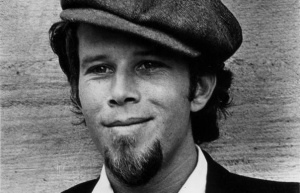
The rest is musical history.
In April, they were saved from starvation or worse by their old friend from The 10 O'Clock Scholar days, Bob Zimmerman - now going by the more Irish sounding "Dylan". They received a telegram in Pompey's Pillar, Montana which read, "Good news ... Stop ... Found a way for you to earn cash ... Stop ... Have market for your songs ... Stop ... Call me ... Stop ... Keep writing ... Don't Stop".
When they called him he told them how he sang their praises to all the new acts springing up that he met as he toured and recorded. These new acts needed material, and would be willing to pay upwards of $20 per song. They were overjoyed. And so it began. What started as a trickle became a raging torrent as the songs became instant hits.
The next three years were busy with the songwriting and playing gigs. They were writing more songs than they were selling, and some say they found an old trunk and used it to hold the extras.
They had quickly moved through Idaho and finally set up in the Puget Sound area where there were more people and opportunities. These were relatively happy times.
They finally decided to head toward their original final destination, Southern California, in the Winter of 1964.
They packed up their gear and played one final gig. With the fruits and vegetables picked up from the stage afterward, they had enough food to reach their next destination.
Welcome to California
It has been rumored that they reached California in January of 1965.
This is an amazing accomplishment - if true - considering they traveled 1,160 miles from Puget Sound to Los Angeles on foot and/or hitchhiking in only approximately 60 days. Their documented poor sense of direction and short attention span makes this even more incredible. We can only assume that they received many rides from friendly "hippies" in Volkswagen Microbuses who knew where Los Angeles was.
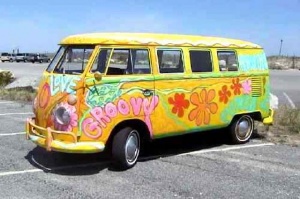
Anyway, during the journey, their style matured into what some call the "finest example of American music".
Leveraging their propensity for securing room and board gratis, they managed to get an invitation from the musical genius with the initials, "BW" to stay at his home. Due to legal issues, we can't get more specific except to say that the band probably had more than a passing influence on his "Pet" project.
Songs that they wrote during this period began to address different issues and themes. Their influence on their host should be apparent to any student of the music of the period.
There is evidence that they met a thirty year old man, one Charles Manson, during their time with "BW".
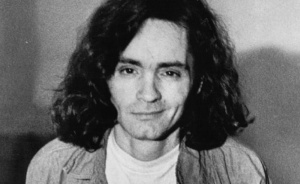
The young man would hang around almost constantly asking anyone there to listen to his songs and help him improve. Since Manson was a friend of "BW's" brother, the boys felt obligated to help him as they had once done with a young Bob Dylan.
After listening to his music, the boys had three suggestions for him:
- Find a girlfriend ... find several. The era of Free Love was nigh.
- Get out of town. Find a remote place to evaluate life and choices.
- Find some other way to achieve fame.
Manson seemed a bit unhappy with the advice, but left to pursue it anyway.
Anyway, one morning they woke up and discovered that a year had passed. It was time to rekindle their passion - Civil Rights.
And they made a plan.
Which they immediately forgot.
Then, they awoke another morning and discovered another 4 months had passed. Clearing away the liquor bottles, rolling papers and drug paraphernalia, they made another plan (which was exactly the same as the one they made 4 months ago).
However, this time they wrote it down.
The Disappearance
Early in May of 1966, they performed their last open air concert in the back yard of Mason Darby for his relatives celebrating Lost Sock Memorial Day.
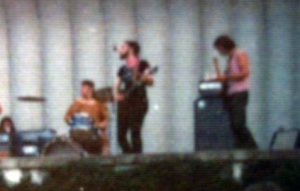
Immediately afterward, they were going to work their way back to Birmingham to perform at the church where it all started. But first, they were going to join the Civil Rights March through Mississippi with James Meredith at the end of May.
While there has been no credible documentation that they arrived in Mississippi and began the march, after the shooting of James Meredith on June 6th, it is very clear that they disappeared - as did their trunk of songs.
Nothing was heard of them again.
Such is the stuff of legends.
The 2013 Discovery
In 2013, Mike Raffone, a well-known connoisseur of flea markets, purports to have found an 8 track cartridge containing an early recording of the band - whom some have dubbed “The I Band” - at one of the first flea markets held in Minneapolis – where they have been illegal for the past 60 years.
For the younger people, at one time all recorded music had to be stored on a physical medium, like vinyl or tape (reel to reel & cassette) or (more recently) CD’s. (And don't get me started about streaming. But I digress.) The 8 Track Cartridge was a giant step forward in portable music technology from vinyl LP’s and reel to reel tape, and was the predecessor of cassette tapes.
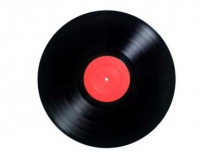
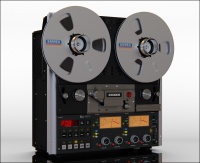

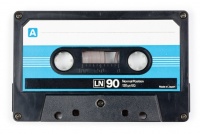
Raffone discovered the cartridge at a table of Dinkytown music memorabilia run by a 90 year old one-eyed Norwegian. The old fellow seemed to have been someone of note in the Minneapolis music scene of the late 50’s/early 60’s.
He explained to Raffone that the 8 track cartridge contained recordings of a band he booked to play at the 10 O’Clock Scholar in the Fall of 1959.
He said that the band sent the 8 track to him in May of 1966 as partial payment of a debt they owed him for room and Torsketunger.

The note that accompanied the cartridge said the music was recorded over a period of six years on their tiny Stuckscheisse reel to reel recorder on cellophane tape and transferred to 8 track cartridge to preserve the recording for posterity in a studio in Southern California.
The cartridge contained songs recorded between the Fall of 1959 and the Spring of 1966. Raffone immediately realized that this could be the mysterious I Band.
The songs show the growth of the band from their early days. And their growth as songwriters.